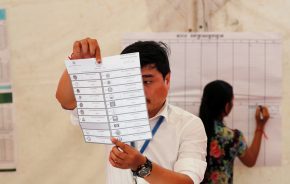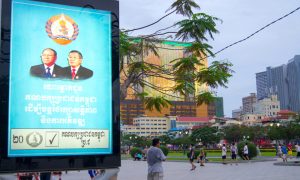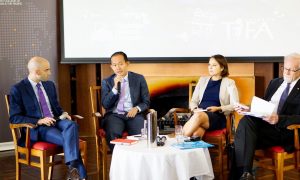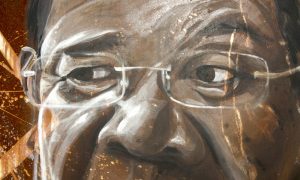It was an intense week for anyone with a stake in Cambodia’s political future. Bold headlines chronicled the story of an impending showdown between Prime Minister Hun Sen and opposition leader Sam Rainsy. The former President of the Cambodia National Rescue Party (CNRP) had vowed to end his self-imposed exile in Paris and create a “historic movement in which the whole Cambodian people will rise up to bring down this brutal dictatorship embodied by Hun Sen.” Cambodia’s Supreme Court had dissolved the CNRP in 2017 and banned 118 senior officials from engaging in any form of political activity just ahead of the parliamentary election in 2018. Rainsy had already fled to France in 2015 while CNRP co-founder and leader Kem Sokha was arrested. The official accusation? A conspiracy with the United States to overthrow the government. To the surprise of no one the ruling Cambodian People’s Party (CPP) won the staged election in a landslide and swept all available parliamentary seats.
Which brings us back to the present: Over the course of the past few weeks, both sides kept raising the stakes and delivered images and soundbites that were threatening and dramatic enough to make Cambodia world news and keep a captivated audience around the globe glued to their newsfeeds.
Rainsy promised to return on November 9, Cambodia’s Independence Day, and went all out with a public good-bye video, stating that this “may just be the last time that you see me alive as a free man.” Cambodian migrant workers and members of the Cambodia diaspora expressed their support and turned out to protest against the Hun Sen regime abroad. The Prime Minister, for his part, threatened airlines with consequences should they allow Rainsy to board a plane, his government cancelled the passports of 12 senior officials and successfully appealed to the Thai Prime Minister to prevent the CNRP leadership from entering his country by evoking the “the spirit of ASEAN”. The Cambodian Ambassador to Indonesia gate-crashed a press conference of CNRP Vice President Mu Sochua. Meanwhile in Cambodia, activists kept a running count of alleged coup-supporters who were rounded up by the Cambodian police. As November 9 drew closer, they posted pictures of the heavy military presence in Phnom Penh and the armed soldiers stationed along the Thai-Cambodian border on social media. The saga resulted in a cliffhanger, with Rainsy and other senior officials barred from entering Thailand, but finally gaining access to Malaysia. While the two opponents have momentarily retreated into their corners, they have also made it clear that the fight is still far from over.
As the clash unfolded, Cambodian analysts, activists, and human rights advocates weighed in through Facebook, Twitter, and various media appearances, discussing the chances of success for Rainsy’s bold plan and the merit of his trying in this dramatic and confrontational manner. Their commentary showed that even among those who support Rainsy’s core demand of an unconditional CNRP reinstatement there are at least three groups that differ substantially in their assessment of the country’s political situation, the lesson they draw from the elections of 2013 and 2017, the vision of change that they subscribe to, and hence the strategies they defend as effective and desirable.
The first groups broadly agrees with Rainsy’s assessment. The opposition leader argues Cambodia is ruled by an illegitimate government, whose leaders are doing the bidding of foreign communist powers. The Cambodian people are economically exploited, their political freedoms violated, they live in fear, despise their leadership, and desperately want change. Due to the dissolution of the country’s main opposition party ahead of the parliamentary election in 2018, they were deprived of their imminent victory. In this view, the injustices experienced by the Cambodian people have led to a state of simmering anger and resentment against their leadership. Rainsy’s return would only provide a well-timed trigger to the already inevitable popular uprising against Hun Sen and his supporters. Supported by the UN and the Western democratic signatories to the 1991 Paris Peace Agreements (PPA), Rainsy would be able to channel the forces thus unleashed into the remaking of the Cambodian state and the realisation of the multiparty, pluralist democracy that the PPA envisioned.
To support this vision, Rainsy and his supporters can firstly point to the election results from 2013 and 2017. The Cambodian National Rescue Party gained 44.46 percent in the parliamentary and 43.83 percent in the communal election. Considering the degree of control that the Cambodian government has over all institutions and branches of government as well as the media, the results were impressive. This led to them swiftly being interpreted as indicative of a much larger constituency whose votes were oppressed or uncounted.
Then there is the reaction of the government itself: the dissolution of the CNRP, the relentless harassment and arrest of prominent opposition leaders and their supporters and the crackdown on the free media. These actions reflect a government that is conscious of its lack of popular legitimacy and lives in fear of its citizens. Finally, there is Sam Rainsy himself. Supporters highlight that he has challenged Hun Sen for almost three decades, yet he is still alive, still able to command worldwide attention, and still in a position to scare Cambodia’s strongman. This alone is often cited as proof of his political savviness and persistence. Taken together, these assessments lead many to argue that Cambodia has reached a crucial turning point. At this moment in the crisis, Rainsy’s supporters conclude that to rally behind him is the country’s best and perhaps last shot at political change.
Notably absent from the voices campaigning for Sam Rainsy to make his way across the Thai-Cambodian border on Independence Day were those considered loyal to Kem Sokha. Formerly the leader of the Human Rights Party (HRP), Sokha decided to join forces with Rainsy in 2012. The CNRP is the result of a merger of his HRP with the Sam Rainsy Party.
The picture of Sokha’s arrest in September of 2017, splashed across the last front-page of the Cambodia Daily under the headline “Descent into outright dictatorship”, has already turned into an icon of a democratic transition interrupted. By and large, his faction shares Rainsy’s bleak assessment of the Cambodian government and the situation of the country and its people. At the same time, its members are wary of Rainsy’s ego and worried that it will interfere with their efforts to free Sokha from prison and reinstate the CNRP. The EU’s threat to suspend the trade privileges Cambodia enjoys under the Everything But Arms scheme is widely seen as the most effective bargaining chip in the negotiations over Sokha’s unconditional release and the reinstatement of political freedoms. The EU released its preliminary report on November 12 and will take a final decision in February 2020.
Where in the world is Cambodia?
The international community needs to take seriously the scepticism of many Cambodians about its intentions.
A premature escalation of the political situation would deprive Sokha’s supporters of this crucial leverage. From their point of view, Rainsy’s provocations and overt threats of a popular uprising in the making were irresponsibly feeding into the very narrative that the Cambodian government had fabricated to rid itself from the opposition in the first place. As such, many of Sokha’s supporters accused Rainsy of recklessly jeopardising the substantial progress the opposition had made through diplomatic channels and behind-the-scenes negotiations. In their assessment of the situation, Rainsy chose to pursue a tactic of escalation because he fears losing his status as the face of the opposition.
Like Rainsy and his supporters, the Kem Sokha faction can highlight the last election results to support their claims. It was only after the 2012 merger that the opposition gained enough popular support to make a significant dent in the CPP’s share of parliamentary seats and shake the government’s confidence.
There is also the fact that Rainsy’s repeated escapes to France contrast unfavourably with Sokha’s lengthy imprisonment in Cambodia. Supporters of both Rainsy and Sokha know that Rainsy’s leadership reputation has suffered as a result. Few would dispute Rainsy’s argument that he is more useful to his people outside of Cambodia than inside a prison. However, this is precisely where more than 50 alleged CNRP’s supporters ended up after Rainsy’s combative public announcement to return to Cambodia to bring down Hun Sen. In the context of growing tensions between the opposition members, these events only served to revive longstanding criticism of Rainsy as an irresponsible leader. This sentiment was probably best expressed in a quote Kem Monovithya tweeted in September 2019. It cites her father Sokha as saying “I made the sacrifice not because I wasn’t afraid, didn’t know the danger or was stupid, but because I understood the difference between a leader & a boss… a leader never asks supporters to do what he isn’t willing to do himself.”
In the discussion over the risks and benefits of Rainsy’s highly publicised return strategy, a third, less well-defined group of actors weighed in. This group consists of Cambodian human rights advocates, youth leaders, media commentators, politicians, and other activists. Some of the more prominent voices belong to Sam Inn or Yang Saing Koma from the Grassroots Democratic Party, Ou Virak, the President of Future Forum, Ou Ritthy, one of the founders of Politikoffee, or Preap Kol, who recently created the One Khmer World movement with three fellow analysts.
Many of them belong to the loosely defined circle of friends, allies, students, and former colleagues of the late Kem Ley. The popular political analyst and media commentator was assassinated in 2016 while drinking his morning coffee. The murder sparked outrage across Cambodia and several people close to him vowed to continue his legacy.
What unites this group of actors is their assertion that for truly sustainable democratic progress to emerge, Cambodia is just as much in need of a different leader as it needs a different style of political engagement. Through a variety of newly founded institutions and organisations they advocate for different, non-confrontational, analytical, and educational approaches to reforming the country’s political institutions and encourage building a new democratic culture and mindset. Integrating and motivating the youth to participate in politics plays a central role. In conversations and interviews, actors often described the essence of this reform approach as an effort to end Cambodia’s bid for populism and personalist leadership by focusing public attention and energy on problem analysis and policies.
In their assessment of the situation this is precisely where the problem with Rainsy’s current strategy lies. The charismatic opposition leader has always drawn strength from his ability to simultaneously address a domestic and international audience. As a result, he presents the political situation in pictures painted with the broadest of brushstrokes and the boldest of colors. To these analysts and commentators, the lack of shades and nuances is not simply a matter of style, but of substance.
They agree that it is necessary to stop and reverse the current political trend towards an increasingly authoritarian government. Pointing to their own long-standing and ongoing productive engagement with a range of actors, these advocates and activists do however object to the characterisation of the Cambodian people as captured by paralysing fear or boiling anger respectively. The criticism they have levelled against Rainsy’s latest provocative moves is therefore less motivated by concerns over his shortcomings as a leader. Rather they reject his assertion that the current situation is so fundamentally deadlocked that it necessitates the most extreme of measures. As a result, they refuse to accept the high price tag that Rainsy currently puts on his more radical visions of political change – especially since they have reason to believe that he will leave it to others to pick up the bill. A violent confrontation with the Cambodian government, or social unrest resulting from an economic downturn should the EU withdraw the EBA, would risk obliterating the zones of negotiation and collaboration they have carefully built over many years in domestic and transnational spaces of interaction.
From this point of view, the election results from 2013 and 2017 can still be interpreted as a clear expression of the people’s desire for a new government. Yet, this expression of their will to bring about change cannot be seamlessly translated into a silent mandate for a political revolution. Many of these activists and advocates are integrated in transnational networks and alliances, highly mobile, and have established channels of communication with diplomatic actors and representatives of various international institutions. As a result, they hold much more pragmatic views of the potential support the Cambodian people would receive from democratically-minded allies and their governments in the case of a public uprising and the Cambodian government’s predictably violent reaction thereto. In short, they do not believe that Western governments will invest time and money into a Paris Peace Conference 2.0.
The coming weeks and months will remain tense. Small concessions by the Cambodian government, such as ending Sokha’s house arrest, are no longer enough to appease observers and the opposition. Until February 2020, the clock set by the EU will continue to tick loudly in the background. Some have argued that those opposing the government’s actions should abstain from any public criticism of Rainsy and show a united front to increase the pressure. This is unlikely to resonate with those who have identified the perpetual zero-sum games of Cambodian politics as the root cause of many of its political troubles.
There are legitimate concerns that a divided opposition or a retreat to conciliatory approaches will ultimately result in failure to challenge the government effectively. Many point to Hun Sen’s time tested strategy of ‘divide and conquer’ in dealing with those who challenge him politically. This strategy, however, rarely demanded the creation of new divisions. Most often, it relied on exploiting and capitalising on those that already existed within.
In sum, precisely because the stakes are so high right now, it would be politically shortsighted to shut down dissenting voices. Any reasonable strategy to turn the country in a different direction fundamentally relies on accurate information about what the people think, want, and are willing to invest in a different political order.
In this regard, it is also important to highlight that while the confrontation between Sen and Rainsy revealed many lines of division it also marked strong points of agreement among Cambodia’s activists and advocates: Firstly, that the Cambodian government has to reverse the injustices done to the CNRP and its members. And secondly, that political change is needed, wanted, and possible.
 Facebook
Facebook  Twitter
Twitter  Soundcloud
Soundcloud  Youtube
Youtube  Rss
Rss 



